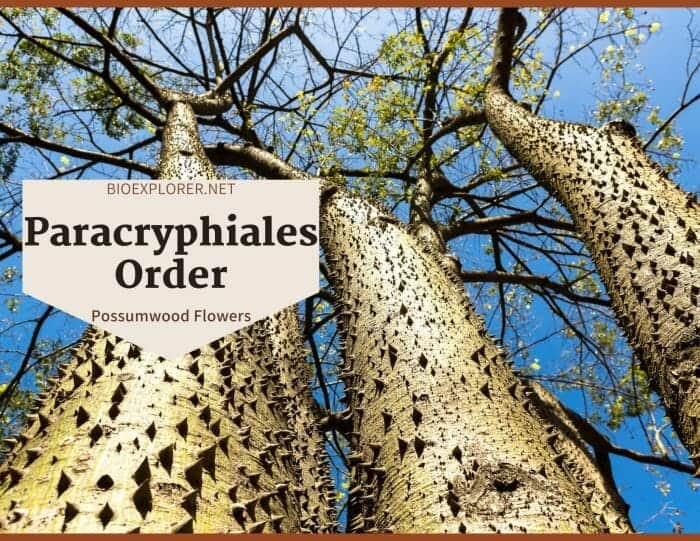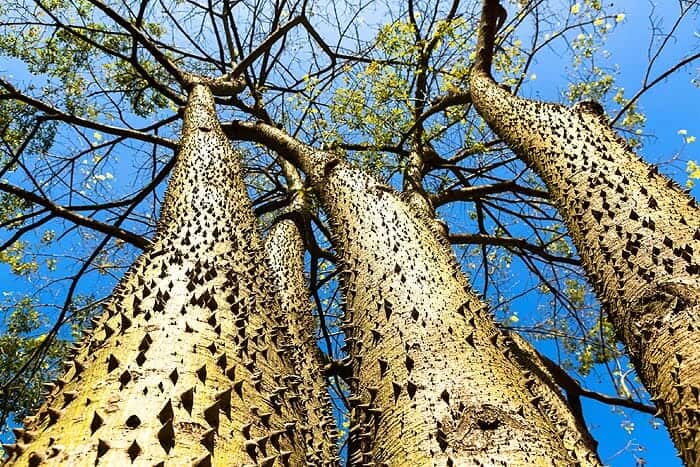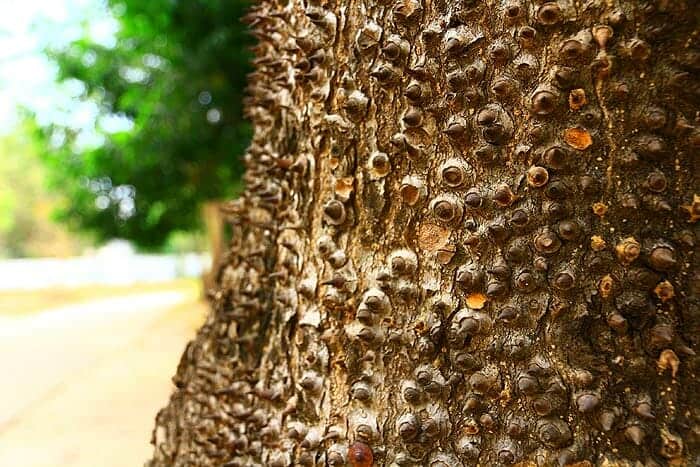
Paracryphiales is an order of flowering plants that belongs to the campanulid clade of the asterids. The trees, shrubs, and vines are distributed in Australia, Southeast Asia, and New Caledonia.
This Possumwood order plants have scaly vegetative buds, simple, alternate, and leathery leaves, and 4-5 sepals and petals. The Paracryphiales plants are hermaphroditeWhat is hermaphrodite?An organism or structure possessing both male and femal reproductive organs; a flower with both stamens and pistils. Other synonyms: bisexual or monoclinous. or andromonoeciousWhat is andromonoecious?A plant with staminate and perfect flowers, but missing pistillate flowers.. Known examples are the grey possumwood and tawheowheo.
The possumwood tree is also known as sandbox tree or exploding fruit tree or dynamite tree, or “no-monkey-climbing” tree due to pointy spines.
Paracryphiales comprise 1 family, 3 genera, and 29 species[1]. Paracryphaceae is the only family of Paracryphiales.
Table of Contents
Paracryphiales Distribution

The members of Paracryphiaceae are distributed in Australia, Southeast Asia, and New Caledonia. The Paracryphia species are endemic to New Caledonia. The species of the genus Quintinia are found in the Philippines, New Guinea, Australia, New Zealand, and New Caledonia. The species of Sphenostemon are growing in New Guinea, Australia, and New Caledonia.
![]()
Paracryphiales Characteristics
- Plant Type: Members are shrubs, medium-sized trees, and vines.
- Stems: Members possess cork cambium and narrow primary medullary rays. The primary vascular tissues are in a cylinder, the separate bundles are absent. There is the development of secondary thickening from a conventional cambial ring. The vessel end-walls of species are very oblique. The fibre tracheids are present in axial xylem.
- Leaves: The species’ leaves are simple, alternate, and leathery. They are petiolate. The lamina is entire, pinnately-veined, cross-venulate. The leaves lack stipules. The lamina margins of the members are finely serrated. The species of Paracryphiales have scaly vegetative buds.
- Flowers and Inflorescences: The flowers are bisexual or unisexual (the plants are andromonoecious). They exist in axillary or terminal racemes or compound spikes.
- Sepals and Petals: Members have 4-5 sepals and 4-5 petals. Some members have tepals with 4 decussate, caducous, free, imbricateWhat is imbricate?overlap or cause to overlap; in botany terms, scales, sepals, or plates having adjacent edges overlapping; with margins of structures overlapping like shingles on a roof. segments.
- Stamens and Carpels: The species have 8 (-11) stamens; filantherous; triplostemonous. The flowers have 8-15 carpels. The gynoecium is syncarpousWhat is syncarpous?Flowering having united carpels; Contrast apocarpous..
- Ovary and Fruits: The ovary of the members is superior or inferior. The fruit is a capsule, septicidal.
- Seeds: The seeds are small, winged, and copiously endospermic.
![]()
Paracryphiales Flowers and Reproduction

The Paracryphiales flowers within the 3 genera are quite florally different. They are bisexual or unisexual. The plants are hermaphrodite or andromonoecious.
- The inflorescences of the flowers are in axillary or terminal racemes. Others are in compound spikes. Some species have differentiated perianth. They possess 4-5 sepals.
- The petals are also 4-5; white, free, and deciduous. The Paracryphia have undifferentiated perianth (tepals) consisting of 4 decussate, caducous, free, and imbricate segments; in 2 whorls.
- The stamens of the members are 4-8; single whorl. Quintinia has an inferior ovary, while Paracryphia has a superior.
![]()
Paracryphiales Genera Differences
All the 3 genera are poorly known, especially Sphenostemon. The following are some of the characteristic differences of the 3 genera.
Paracryphia
- The species is a small tree or shrub.
- The plant is andromonoecious.
- The flowers are sessile; the inflorescence is branched.
- The seeds are winged.
![]()
Quintinia
- Members of this genus are evergreen trees and shrubs.
- The plants have alternate and serrate leaves. They are exstipulateWhat is exstipulate?Without stipules; Stipule is a small structure of appendage found at the base of some leaf petioles..
- Peltate scales covered the plants.
- The plants possess elagic acid along with iridoidsWhat is iridoids?Iridoids are medicinal compound (aka metabolites) found in many plants; they possess neuroprotective, hepatoprotective, anti-inflammatory, antitumor, hypoglycemic, and hypolipidemic activities..
- The flowers are at the end of the stalks or on the axils of the leaf.
- The flowers can be bisexual or unisexual.
- Plants possess bitegmic ovules.
- The fruit is a capsule, often with numerous tiny seeds. The seeds are flattened and shortly winged.
![]()
Sphenostemon
- The members are usually evergreen trees.
- The leaves are simple, leathery, sub-opposite to pseudo-whorled. The leaves are strong serrate. They lack stipules.
- The flowers are bisexual.
- There are 4 free and widely imbricate sepals. The petals are 0-4, all caducous during anthesis.
- The fruit is fleshy with 2 seeds.
![]()
Paracryphiales Example Species
Not much information has been known about the species of Paracryphiales.
- Paracryphia alticola
- Tawheowheo[2]
- Possumwood[3] – The wood is fit for small turning and carving.
- Grey possumwood – The plant has horticultural potential because of its noticeable flowers.
- Quintinia oreophila
- Quintinia altigena
- Quintinia hyehenensis[4] – This shrub is endangered.
- Quintinia notantifora
- Sphenostemon balansae[5]
- Sphenostemon oppositifolius – The population of this species is decreasing; near threatened.
![]()










